1
MS350 Series
MS350 Series
KEM-ML36100-15
Safety and General Information
Important Information on Safe and Efficient Operation
Read This Information Before Using The Radio.
The information provided in this document supersedes the general
safety information in user guides published prior to December 1, 2002.
Transmit and Receive Procedure
This two-way radio contains a transmitter and a receiver. To
control your exposure and ensure compliance with the general
population/uncontrolled environment exposure limits, always
adhere to the following procedure:
• Transmit no more than 50% of the time.
• To receive calls, release the PTT button.
• To transmit (talk), press the Push to Talk (PTT) button.
Transmitting 50% of the time, or less, is important because the
radio generates measurable RF energy exposure only when
transmitting (in terms of measuring standards compliance).
Exposure to Radio Frequency Energy
This Motorola two-way radio complies with the following RF
energy exposure standards and guidelines:
• United States Federal Communications Commission, Code of
Federal Regulations; 47CFR part 2 sub-part J.
• American National Standards Institute (ANSI)/Institute of
Electrical and Electronic Engineers (IEEE) C95. 1-1992.
• Institute of Electrical and Electronics Engineers (IEEE) C95.
1-1999 Edition.
• International Commission on Non-Ionizing Radiation
Protection (ICNIRP) 1998.
• Ministry of Health (Canada) Safety Code 6. Limits of Human
Exposure to Radiofrequency Electromagnetic Fields in the
Frequency Range from 3 KHz to 300 GHz, 1999.
• Australian Communications Authority Radiocommunications
(Electromagnetic Radiation—Human Exposure) Standard, 2003.
• ANATEL ANNEX to Resolution No. 303 of July 2, 2002.
• ANATEL ANNEX to Resolution No. 533 of September 10, 2009.
To ensure optimal radio performance and make sure human
exposure to radio frequency electromagnetic energy is within
the guidelines set forth in the above standards, always adhere
t
o the following procedures.
Portable Radio Operation and EME Exposure
A
ntenna Care
U
se only the supplied or an approved replacement antenna.
U
nauthorized antennas, modifications, or attachments could
d
amage the radio and may violate FCC regulations.
D
o NOT hold the antenna when the radio is “IN USE.” Holding
t
he antenna affects its effective range.
Body-Worn Operation
To maintain compliances with FCC guidelines if you wear a radio
on your body when transmitting always place the radio in a
M
otorola-supplied or approved clip holder, holster, case or body
h
arness for this product. Use of non-Motorola-approved
a
ccessories may exceed FCC guidelines.
I
f you do not use one of the Motorola-supplied or approved
body-worn accessories and are not using the radio held in the
normal use position, ensure the radio and its antenna are at
least 1 inch (2.5 cm) from your body when transmitting.
Data Operation
I
f applicable, when using any data feature of the radio with or
w
ithout an accessory cable, position the radio and its antenna
a
t least one inch (2.5 cm) from the body.
Approved Accessories
5
3724: Remote Speaker with Push-to-Talk Microphone
5
3725: Headset with Swivel Boom Microphone
5
3727: Ear bud with Push-to-Talk Microphone
53728: Flexible Ear Receiver
56320: Earpiece with Boom Microphone
E
lectromagnetic Interference/Compatibility
Note: Nearly every electronic device is susceptible to
electromagnetic interference (EMI) if inadequately shielded,
designed or otherwise configured for electromagnetic
compatibility. This device complies with Part 15 of the FCC Rules.
Operation is subject to the following two conditions:
1. This device may not cause harmful interference; and
2. This device must accept any interference received,
including interference that may cause undesired operation.
Facilities
To avoid electromagnetic interference and/or compatibility
conflicts, turn off the radio in any facility where posted notices
instruct you to do so. Hospitals or health care facilities may be
using equipment that is sensitive to external RF energy.
Aircraft
When instructed to do so, turn off the radio when onboard an
aircraft. Any use of a radio must be in accordance with
applicable regulations per airline crew instructions.
Medical Devices – Pacemakers
The Advanced Medical Technology Association recommends
that a minimum separation of 6 inches (15 cm) be maintained
between a handheld wireless radio and a pacemaker. These
recommendations are consistent with the independent research
by and recommendations of the U.S. Food and Drug
Administration.
People with pacemakers should:
• ALWAYS keep the radio more than 6 inches (15 cm) from
their pacemaker when the radio is turned ON.
• Not carry the radio in the breast pocket.
• Use the ear opposite the pacemaker to minimize the
potential for interference.
• Turn the radio OFF immediately if there is any reason to
suspect that interference is taking place.
Medical Devices – Hearing Aids
Some digital wireless radios may interfere with some hearing
aids. In the event of such interference, you may want to consult
your hearing aid manufacturer to discuss alternatives.
Medical Devices – Other
If you use any other personal medical device, consult the
manufacturer of your device to determine if it is adequately
shielded from RF energy. Your physician may be able to assist
you in obtaining this information.
For More Information
For further information, you may call Motorola at 1-800-638-5119,
e-mail us at giantintl@callcenter.com or visit us on the Internet
at www.motorola.com.
Safety and General Use While Driving
Check the laws and regulations regarding the use of radios in
the area where you drive, and always obey them. If you do use
t
he radio while driving, please:
•
Give full attention to driving and to the road.
• Use hands-free operation, if available.
• Pull off the road and park before making or answering a call
if driving conditions so require.
T
he use of a two-way radio while engaged in activities requiring
concentration may cause distraction or otherwise impair your
ability to safely participate in such activities. Always use
technology safely.
Do not place a portable radio in the area over an air bag or in the
a
ir bag deployment area. Air bags inflate with great force. If a
p
ortable radio is placed in the air bag deployment area and the
a
ir bag inflates, the radio may be propelled with great force and
c
ause serious injury to occupants of the vehicle.
Potentially Explosive Atmospheres
Turn off the radio prior to entering any area with a potentially
explosive atmosphere. Only radio types that are especially
q
ualified should be used in such areas as “Intrinsically Safe.”
D
o not remove, install or charge batteries in such areas. Sparks
i
n a potentially explosive atmosphere can cause an explosion or
fire resulting in bodily injury or even death.
N
ote: The areas with potentially explosive atmospheres referred
to above include fueling areas such as below decks on boats,
fuel or chemical transfer or storage facilities, areas where the air
c
ontains chemicals or particles (such as grain, dust or metal
powders) and any other area where you would normally be
advised to turn off your vehicle engine. Areas with potentially
explosive atmospheres are often—but not always—posted.
Blasting Caps and Areas
T
o avoid possible interference with blasting operations, turn off
the radio when you are near electrical blasting caps, in a
blasting area, or in areas posted “Turn off two-way radios.”
Obey all signs and instructions.
Operational Cautions
Antennas
Do not use any portable radio that has a damaged antenna. If a
damaged antenna comes into contact with your skin, a minor
burn can result.
Batteries
All batteries can cause property damage and/or bodily injury such
as burns if a conductive material—like jewelry, keys or beaded
chains— touch exposed terminals. The conductive material may
complete an electrical circuit (short circuit) and become quite hot.
Exercise care in handling any charged battery, particularly when
placing it inside a pocket, purse or other container with metal
objects.
Exercise care when removing NiMH or AA batteries. Do not use
sharp or conductive tools to remove either of these batteries.
Battery Charger Safety Instructions:
Save these Instructions
1. Do not expose the charger to rain or snow.
2. Do not operate or disassemble the charger if it has received
a sharp blow, or has been dropped or damaged in any way.
3. Never alter the AC cord or plug provided with the unit. If the
plug will not fit the outlet, have the proper outlet installed by
a qualified electrician. An improper condition can result in a
risk of electric shock.
4. To reduce the risk of damage to the cord or plug, pull the
plug rather than the cord when disconnecting the charger
from the AC receptacle.
5. To reduce the risk of electric shock, unplug the charger from
the outlet before attempting any maintenance or cleaning.
6. Use of an attachment not recommended or sold by Motorola
may result in a risk of fire, electric shock or personal injury.
7. Make sure the cord is located so it will not be stepped on,
tripped over or subjected to damage or stress.
8. An extension cord should not be used unless absolutely
necessary. Use of an improper extension cord could result in
a risk of a fire and/or electric shock. If an extension cord
must be used, make sure that:
• The pins on the plug of the extension cord are the same
number, size and shape as those on the plug of the
charger.
®
Two-Way Radio
User’s Guide
T
he MS350R is approved for use in the US only.
T
his radio floats with included NiMH battery.
It may not float with some AA batteries.
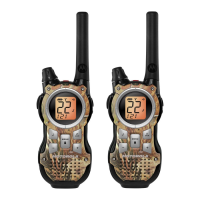
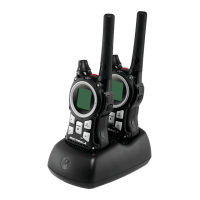
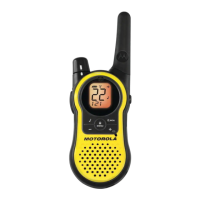
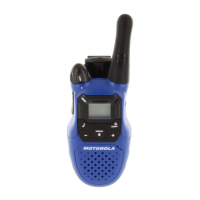
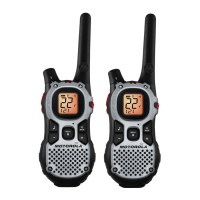
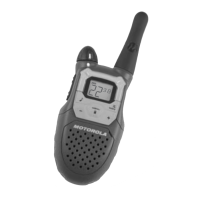
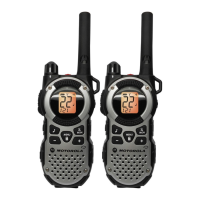
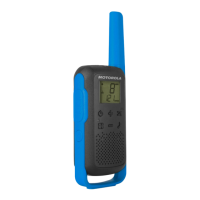
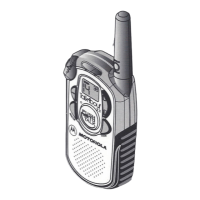

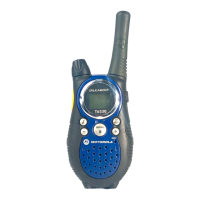
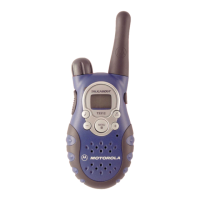
